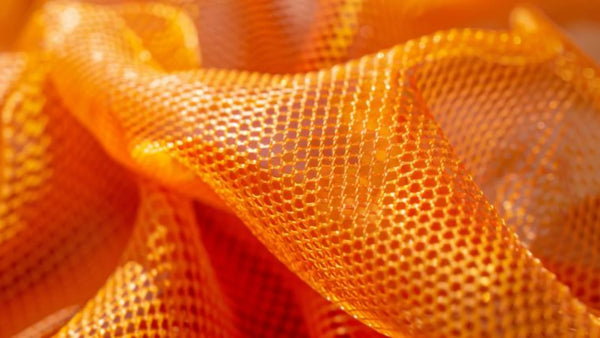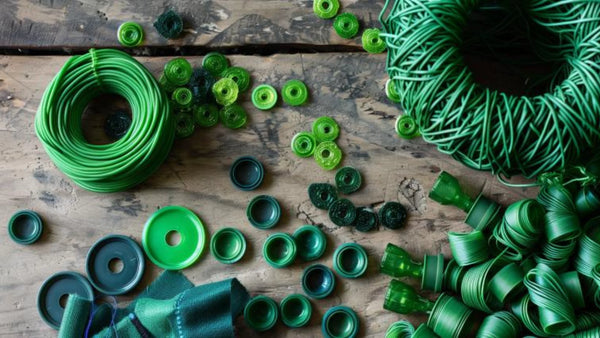Key Takeaways
polyamide, also known as nylon, is a very strong and durable synthetic polymer, ideal for many applications ranging from sportswear automobile parts. Its main characteristics are its great resistance, its lightness, its impermeability and its flexibility. It is manufactured from petroleum resources by a polymerization process involving reactions between diacids and diamines.
The Oversized Hoodie® is THE French brand 🇫🇷 specialist in cocooning recognized for its high quality certified Oeko-Tex® Standard 100, non-toxic, non-chemical, 100% vegan and cruelty-free. Among our products, a large number have been awarded the international quality label "Confiance Textile", for their manufacturing quality, which is highly appreciated by our customers.
Understanding polyamide
What is polyamide ?
polyamide is a synthetic fiber obtained by polymerization of molecules containing amide groups (-CO-NH-). It is a semi-crystalline thermoplastic polymer very widespread in many industrial sectors thanks to its remarkable mechanical and chemical properties.
Origin and manufacture of polyamide
Polyamide was discovered in 1935 by Wallace Carothers, a chemist working for the DuPont company. He developed this new synthetic polymer with the aim of creating a fiber as strong as natural silk, but at a lower cost.
The production of polyamide involves a complex manufacturing process derived from petrochemicals. The main steps are:
- Mixture of diacids and diamines molecules which react to form amide bonds.
- Polymerization of these molecules into long polyamide chains.
- Spinning the molten polymer into ultra-fine fibers.
This process makes it possible to obtain different types of polyamides with varied properties, such as polyamide 6, 6.6 or even 11 and 12.
The different types of polyamides
There are many types of polyamides classified according to their chemical composition. The most common are:
- Polyamide 6 (PA 6): Obtained by polymerization of caprolactam. Widely used for textile fibers.
- Polyamide 6.6 (PA 6.6): Also called nylon, produced from hexamethylenediamine and adipic acid. Very resistant, it is used in particular for tires and gears.
- Polyamide 11 (PA 11): Derived from vegetable oils, it is biosourced and resistant to UV and shock.
- Polyamide 12 (PA 12): Offers great flexibility, good chemical and thermal resistance. Used for coverings and sheaths.
Characteristics and properties of polyamide
Polyamides are distinguished by their strength, their lightness, their elasticity and their impermeability. They resist wear, shock, chemicals and withstand high temperatures without deteriorating. Their low density makes them inexpensive materials to produce.
However, polyamides tend to absorb moisture, which can alter their dimensional properties. They are also sensitive to UV rays which can weaken them over time. Their oil-based production also raises environmental questions.
- $25.2 billion: the estimated size of the global polyamide market in 2029, with a CAGR of 6.44% between 2023 and 2029. [Source]
- 72.45% of global automobile production in 2022 came from Asia-Pacific, the dominant region for the polyamide market. [Source]
- 300 times more powerful than CO2: nitrous oxide (N2O) emitted during the production of polyamide is a very harmful greenhouse gas. [Source]

Advantages of Polyamide
Durability and resistance
One of the main advantages of polyamide is its great resistance to wear, impact, chemicals and high temperatures. This very strong and durable synthetic fiber is ideal for making sports clothing, parachute fabrics, fishing nets and others demanding applications.
Flexibility of use
Thanks to its properties of flexibility and elasticity, polyamide can be used to create threads, tights, swimsuits close to the body or even tightening collars. Its lightness also makes it a material of choice for the aeronautics industry.
Environmental benefits
Although derived from petroleum resources, polyamide has certain environmental benefits. Its low water absorption rate makes it less susceptible to mold. In addition, some types such as polyamide 11 are biosourced from vegetable oils renewable. recycled polyamide is also an eco-responsible alternative.

Applications of polyamide
Polyamide in the textile industry
The use of polyamide in the manufacture of clothing
Polyamide is one of the materials most used in the making of clothing thanks to its robustness, breathability and ease of maintenance. It is found in particular in sportswear, swimwear, tights and underwear.
Nylon: a popular type of polyamide
nylon, which is a specific type of polyamide 6.6, is particularly appreciated in the textile industry for its high resistance to wear and to tear. It is used in the composition of many clothes but also of technical fabrics such as parachute fabrics.
As a brand specializing in oversized clothing, we have chosen to use polyamide for our collections because it is a material that is both robust and comfortable, ideal for loose pieces. Its great elasticity allows a perfect fit without restricting movements.
— Geoffrey, Founder of The Oversized Hoodie®
Polyamide in the automotive industry
Polyamides are also widely used in the manufacture of automotive parts thanks to their robustness, their resistance to chemical products and high temperatures . They are found in tires, hoses, gears and many other components under the hood.
Other notable applications
Beyond textiles and automobiles, polyamide is used in many other areas such as construction (electrical conduits, seals), sports equipment (tennis rackets, hiking shoes) or even industrial packaging (straps, strings).

Polyamide versus other textile materials
Polyamide or nylon ?
Although often used as synonyms, polyamide in fact designates the family of synthetic polymers of which nylon (polyamide 6.6) is only a particular type. Nylon is distinguished by its very high mechanical resistance and its exceptional robustness.
This is why nylon is favored for the most demanding applications such as parachute webs, climbing ropes or automobile tires . But other types of polyamides such as polyamide 6 are more suitable for clothing and textiles where a certain flexibility is required.
Polyamide or polyester ?
polyester is another very common synthetic fiber, lighter than polyamide but also less resistant. Unlike polyester which tends to repel moisture, polyamide absorbs perspiration better which makes it more breathable for sportswear.
In addition, polyamide fabrics generally have better elasticity and greater resistance to chemicals than polyester. This is what makes polyamide a preferred choice for swimsuits and other clothing close to the body.
Also read: Polyamide or polyester ?
Polyamide or acrylic ?
acrylic is a synthetic fiber that is very warm and soft to the touch, but which peels and wears much more easily than polyamide. The latter offers significantly greater durability and resistance to wear for clothing.
In addition, acrylic fabrics tend to release micro-particles of plastic when washing, which is not the case with more environmentally friendly polyamide. This is why polyamide remains the preferred material for brands of technical and outdoor clothing.
Polyamide or cotton ?
cotton is a natural fiber that is very breathable and soft on the skin. But unlike polyamide, cotton tends to wrinkle, shrink and lose its shape after a few washes. clothing made of polyamide is much more easy to maintain.
Polyamide is also more waterproof than cotton, making it ideal for clothing intended for outdoor activities.Its great resistance to chemical products and high temperatures also makes it a better choice for work outfits for example.
Polyamide or wool ?
Like wool, polyamide is an insulating fiber which protects well from the cold. But wool has a lower water-repellency than polyamide and must be washed more delicately to avoid felt. clothing made of polyamide is more waterproof and easy to maintain.
In return, wool is a natural fiber that is more breathable than synthetic polyamide. It therefore remains preferred for sweaters and warm clothing worn next to the skin. Polyamide is best suited as a technical outer layer.
Polyamide or polyurethane ?
polyurethane is a very elastic plastic used in particular for tight-fitting clothing and tights. But while it offers great flexibility, polyurethane is much less breathable and durable than polyamide for sportswear for example.
Polyamide remains the preferred material for exercise outfits thanks to its exceptional resistance, its lightness and its ability to wick away perspiration. Its use in sports equipment such as rackets or shoes also remains unrivaled.
Also read: What is the hottest material ?

Specific applications of polyamide
Polyamide in the manufacture of ropes and threads
Thanks to its exceptional resistance, polyamide is used in the composition of many threads and ropes for multiple uses such as climbing ropes , packing strings or even fishing lines.
The use of polyamide in waterproof textiles
Polyamide fabrics are particularly waterproof and breathable, making them an excellent choice for making clothing and equipment intended for outdoors such as camping tents or oils.

Recently, we received very positive feedback from a Spanish customer, Maria, who purchased our fleece leggings.
She explained to us that after several years of intensive use for her winter hikes, the garment remained intact and retained its initial shape despite the difficult conditions.
It is the great strength and durability of polyamide that has allowed it to last so long.
Stories like this reinforce our belief in using this high-performance material for some of our collections.
The environmental issue of polyamide
Ecological impact of polyamide production
Although technically very efficient, polyamide raises certain questions from an environmental point of view. Its production from non-renewable oil resources generates emissions of greenhouse gases. In addition, the release of micro-particles of polyamide when washing clothes pollutes the oceans.
At The Oversized Hoodie®, we are aware of the environmental challenges associated with polyamide. This is why we are actively working to develop ranges in recycled and biosourced polyamide, in order to offer our customers sustainable clothing without compromising comfort and quality.
— Geoffrey, Founder of The Oversized Hoodie®
Recycled polyamide: an eco-responsible alternative ?
To reduce environmental impact, a promising solution is the development of recycled polyamides from plastic waste. Some brands already offer collections of clothing in recycled polyamide. But efforts remain to be made for a sustainable recycling sector.
Also read: What material to wear in summer ?

How to maintain polyamide fabrics ?
Tips for washing polyamide clothing
clothing made of polyamide is very easy to maintain. They can be machine washed at 30-40°C with a mild detergent. However, avoid washing too frequently, which accelerates the wear of the fibers. Dry them preferably flat to avoid deformation.
How to dye polyamide clothing ?
Unlike natural fibers, polyamide is more difficult to dye evenly. To obtain a good result, it is recommended to use special dyes for nylon and to carefully follow the dyeing process adapted to this synthetic fiber.
Conclusion
Polyamide is a synthetic material with multiple advantages which explain its success in many areas of application. Its great resistance, its lightness, its flexibility and its waterproofing make it an ideal choice for sports clothing, technical equipment or automobile parts.
Despite some environmental challenges, polyamide remains a fiber of the future thanks to innovations such as biosourced polyamide or recycled. There is no doubt that this high-performance material will continue to develop in the years to come.
| Characteristic | Description |
|---|---|
| Origin | Synthetic, derived from petrochemicals |
| Main properties | Durable, lightweight, flexible, waterproof |
| Common applications | Sports clothing, automobile parts, technical equipment |
| Environmental benefits | Biosourced polyamide 11, recycled polyamide |
| Maintenance | Machine wash at 30-40°C, dry flat |
FAQ
Which is warmer: polyamide or polyester ?
polyamide is generally considered to be more warmer and insulating than polyester. It absorbs body moisture better, making it more suitable for outerwear in cold weather.
What is the difference between polyamide and polyester ?
The main difference is that polyamide is a fiber that is stronger, more elastic and more breathable than polyester. Polyamide absorbs more moisture while polyester tends to repel it.
What is polyamide material ?
polyamide is a very strong and durable synthetic polymer, made from petroleum resources. It is a textile fiber widely used for sports clothing, ropes or automobile parts thanks to its resistance.
Is polyamide good for the skin ?
Polyamide is a synthetic fiber generally well tolerated by the skin because it is not very irritating. However, like any material, it can cause allergic reactions in certain sensitive people.
References
[1] "Polyamide (nylon): its advantages and disadvantages - Definition - Marques de France", Marques de France
[2] "EP2563841A2 - Process for manufacturing polyamide - Google Patents", Google Patents
[3] "A critical review on the manufacturing processes and performance of polyamide biocomposites from a biofiller perspective - ScienceDirect", ScienceDirect
[4] "Polyamide | Formula, properties and application", Material Properties






